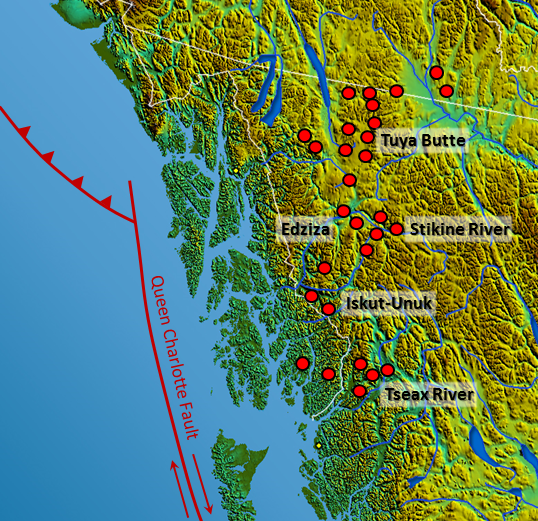4.1: Plate Tectonics and Volcanism
- Page ID
- 7785
\( \newcommand{\vecs}[1]{\overset { \scriptstyle \rightharpoonup} {\mathbf{#1}} } \)
\( \newcommand{\vecd}[1]{\overset{-\!-\!\rightharpoonup}{\vphantom{a}\smash {#1}}} \)
\( \newcommand{\dsum}{\displaystyle\sum\limits} \)
\( \newcommand{\dint}{\displaystyle\int\limits} \)
\( \newcommand{\dlim}{\displaystyle\lim\limits} \)
\( \newcommand{\id}{\mathrm{id}}\) \( \newcommand{\Span}{\mathrm{span}}\)
( \newcommand{\kernel}{\mathrm{null}\,}\) \( \newcommand{\range}{\mathrm{range}\,}\)
\( \newcommand{\RealPart}{\mathrm{Re}}\) \( \newcommand{\ImaginaryPart}{\mathrm{Im}}\)
\( \newcommand{\Argument}{\mathrm{Arg}}\) \( \newcommand{\norm}[1]{\| #1 \|}\)
\( \newcommand{\inner}[2]{\langle #1, #2 \rangle}\)
\( \newcommand{\Span}{\mathrm{span}}\)
\( \newcommand{\id}{\mathrm{id}}\)
\( \newcommand{\Span}{\mathrm{span}}\)
\( \newcommand{\kernel}{\mathrm{null}\,}\)
\( \newcommand{\range}{\mathrm{range}\,}\)
\( \newcommand{\RealPart}{\mathrm{Re}}\)
\( \newcommand{\ImaginaryPart}{\mathrm{Im}}\)
\( \newcommand{\Argument}{\mathrm{Arg}}\)
\( \newcommand{\norm}[1]{\| #1 \|}\)
\( \newcommand{\inner}[2]{\langle #1, #2 \rangle}\)
\( \newcommand{\Span}{\mathrm{span}}\) \( \newcommand{\AA}{\unicode[.8,0]{x212B}}\)
\( \newcommand{\vectorA}[1]{\vec{#1}} % arrow\)
\( \newcommand{\vectorAt}[1]{\vec{\text{#1}}} % arrow\)
\( \newcommand{\vectorB}[1]{\overset { \scriptstyle \rightharpoonup} {\mathbf{#1}} } \)
\( \newcommand{\vectorC}[1]{\textbf{#1}} \)
\( \newcommand{\vectorD}[1]{\overrightarrow{#1}} \)
\( \newcommand{\vectorDt}[1]{\overrightarrow{\text{#1}}} \)
\( \newcommand{\vectE}[1]{\overset{-\!-\!\rightharpoonup}{\vphantom{a}\smash{\mathbf {#1}}}} \)
\( \newcommand{\vecs}[1]{\overset { \scriptstyle \rightharpoonup} {\mathbf{#1}} } \)
\( \newcommand{\vecd}[1]{\overset{-\!-\!\rightharpoonup}{\vphantom{a}\smash {#1}}} \)
\(\newcommand{\avec}{\mathbf a}\) \(\newcommand{\bvec}{\mathbf b}\) \(\newcommand{\cvec}{\mathbf c}\) \(\newcommand{\dvec}{\mathbf d}\) \(\newcommand{\dtil}{\widetilde{\mathbf d}}\) \(\newcommand{\evec}{\mathbf e}\) \(\newcommand{\fvec}{\mathbf f}\) \(\newcommand{\nvec}{\mathbf n}\) \(\newcommand{\pvec}{\mathbf p}\) \(\newcommand{\qvec}{\mathbf q}\) \(\newcommand{\svec}{\mathbf s}\) \(\newcommand{\tvec}{\mathbf t}\) \(\newcommand{\uvec}{\mathbf u}\) \(\newcommand{\vvec}{\mathbf v}\) \(\newcommand{\wvec}{\mathbf w}\) \(\newcommand{\xvec}{\mathbf x}\) \(\newcommand{\yvec}{\mathbf y}\) \(\newcommand{\zvec}{\mathbf z}\) \(\newcommand{\rvec}{\mathbf r}\) \(\newcommand{\mvec}{\mathbf m}\) \(\newcommand{\zerovec}{\mathbf 0}\) \(\newcommand{\onevec}{\mathbf 1}\) \(\newcommand{\real}{\mathbb R}\) \(\newcommand{\twovec}[2]{\left[\begin{array}{r}#1 \\ #2 \end{array}\right]}\) \(\newcommand{\ctwovec}[2]{\left[\begin{array}{c}#1 \\ #2 \end{array}\right]}\) \(\newcommand{\threevec}[3]{\left[\begin{array}{r}#1 \\ #2 \\ #3 \end{array}\right]}\) \(\newcommand{\cthreevec}[3]{\left[\begin{array}{c}#1 \\ #2 \\ #3 \end{array}\right]}\) \(\newcommand{\fourvec}[4]{\left[\begin{array}{r}#1 \\ #2 \\ #3 \\ #4 \end{array}\right]}\) \(\newcommand{\cfourvec}[4]{\left[\begin{array}{c}#1 \\ #2 \\ #3 \\ #4 \end{array}\right]}\) \(\newcommand{\fivevec}[5]{\left[\begin{array}{r}#1 \\ #2 \\ #3 \\ #4 \\ #5 \\ \end{array}\right]}\) \(\newcommand{\cfivevec}[5]{\left[\begin{array}{c}#1 \\ #2 \\ #3 \\ #4 \\ #5 \\ \end{array}\right]}\) \(\newcommand{\mattwo}[4]{\left[\begin{array}{rr}#1 \amp #2 \\ #3 \amp #4 \\ \end{array}\right]}\) \(\newcommand{\laspan}[1]{\text{Span}\{#1\}}\) \(\newcommand{\bcal}{\cal B}\) \(\newcommand{\ccal}{\cal C}\) \(\newcommand{\scal}{\cal S}\) \(\newcommand{\wcal}{\cal W}\) \(\newcommand{\ecal}{\cal E}\) \(\newcommand{\coords}[2]{\left\{#1\right\}_{#2}}\) \(\newcommand{\gray}[1]{\color{gray}{#1}}\) \(\newcommand{\lgray}[1]{\color{lightgray}{#1}}\) \(\newcommand{\rank}{\operatorname{rank}}\) \(\newcommand{\row}{\text{Row}}\) \(\newcommand{\col}{\text{Col}}\) \(\renewcommand{\row}{\text{Row}}\) \(\newcommand{\nul}{\text{Nul}}\) \(\newcommand{\var}{\text{Var}}\) \(\newcommand{\corr}{\text{corr}}\) \(\newcommand{\len}[1]{\left|#1\right|}\) \(\newcommand{\bbar}{\overline{\bvec}}\) \(\newcommand{\bhat}{\widehat{\bvec}}\) \(\newcommand{\bperp}{\bvec^\perp}\) \(\newcommand{\xhat}{\widehat{\xvec}}\) \(\newcommand{\vhat}{\widehat{\vvec}}\) \(\newcommand{\uhat}{\widehat{\uvec}}\) \(\newcommand{\what}{\widehat{\wvec}}\) \(\newcommand{\Sighat}{\widehat{\Sigma}}\) \(\newcommand{\lt}{<}\) \(\newcommand{\gt}{>}\) \(\newcommand{\amp}{&}\) \(\definecolor{fillinmathshade}{gray}{0.9}\)The relationships between plate tectonics and volcanism are shown on Figure \(\PageIndex{1}\). As summarized in Chapter 3, magma is formed at three main plate-tectonic settings: divergent boundaries (decompression melting), convergent boundaries (flux melting), and mantle plumes (decompression melting).

The mantle and crustal processes that take place in areas of volcanism are illustrated in Figure \(\PageIndex{2}\). At a spreading ridge, hot mantle rock moves slowly upward by convection (centimetre/year), and within about 60 kilometers (km) of the surface, partial melting starts because of decompression. Over the triangular area shown in Figure \(\PageIndex{2}\)a, about 10% of the ultramafic mantle rock melts, producing mafic magma that moves upward toward the axis of spreading (where the two plates are moving away from each other). The magma fills vertical fractures produced by the spreading and spills out onto the sea floor to form basaltic pillows (more on that later) and lava flows. There is spreading-ridge volcanism taking place about 200 km offshore from the west coast of Vancouver Island.
Figure \(\PageIndex{2}\)a shows a triangular zone about 60 km thick; within this zone, approximately 10% of the mantle rock melts to form oceanic crust. Based on this information, approximately how thick do you think the resulting oceanic crust should be?

See Appendix 3 for Exercise 4.1 answers.
At an ocean-continent convergent boundary, part of a plate that is made up of oceanic crust is subducting beneath part of another plate made up of continental crust. At an ocean-ocean convergent boundary, oceanic crust is being subducted beneath another oceanic-crust plate.[/footnote] (Figure \(\PageIndex{2}\)b). In both situations the oceanic crust is heated up, and while there isn’t enough heat to melt the subducting crust, there is enough heat to force the water out of some of its minerals. This released water rises into the overlying mantle where it contributes to flux melting of the mantle rock. The mafic magma produced rises through the mantle to the base of the crust. There it contributes to partial melting of crustal rock, and thus it assimilates much more felsic material. That magma, now likely intermediate in composition, continues to rise and assimilate crustal material. In the upper part of the crust, it accumulates into plutons. From time to time, the magma from the plutons rises toward surface, leading to volcanic eruptions. Mount Garibaldi (Figures 4.0.1 and 4.0.2) is an example of subduction-related volcanism.
A mantle plume is an ascending column of hot rock (not magma) that originates deep in the mantle, possibly just above the core-mantle boundary. Mantle plumes are thought to rise approximately 10 times faster than the rate of mantle convection. The ascending column may be on the order of kilometers to tens of kilometers across, but near the surface it spreads out to create a mushroom-style head that is several tens to over 100 km across. Near the base of the lithosphere (the rigid part of the mantle), the mantle plume (and possibly some of the surrounding mantle material) partially melts to form mafic magma that rises to feed volcanoes. Since most mantle plumes are beneath the oceans, the early stages of volcanism typically take place on the sea floor. Over time, islands may form like those in Hawaii.
Volcanism in northwestern B.C. (Figures 4.1.3 and 4.1.4) is related to continental rifting. This area is not at a divergent or convergent boundary, and there is no evidence of an underlying mantle plume. A likely explanation is that the crust of northwestern B.C. is being stressed by the northward movement of the Pacific Plate against the North America Plate, and the resulting crustal fracturing provides a conduit for the flow of magma from the mantle. This may, or may not, be an early stage of continental rifting, such as that found in eastern Africa.


Media Attributions
- Figure \(\PageIndex{1}\): Understanding Plate Motions by USGS. Public domain. Modified by Steven Earle.
- Figure \(\PageIndex{2}\): By USGS. Public domain. Modified by Steven Earle.
- Figure \(\PageIndex{3}\): “South-West Canada” by USGS. Public domain. Modified by Steven Earle. Volcanic locations from Edwards, B. & Russell, J. (2000). Distribution, nature, and origin of Neogene-Quaternary magmatism in the northern Cordilleran volcanic province, Canada. Geological Society of America Bulletin. pp. 1280-1293 [Steven Earle] Cordillera Volcanic Province, B.C.
- Figure \(\PageIndex{4}\): © Steven Earle. CC BY.


